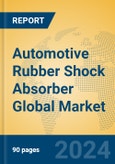Market Overview
The automotive rubber shock absorber market has been steadily growing due to the rising automotive sales, advancements in shock absorber technology, and increasing demand for vehicle comfort and safety. The global automotive shock absorber market is projected to expand at a CAGR of approximately 6% to 8% during the 2025-2030 period. One of the major driving forces behind this growth is the shift towards lightweight materials and improved designs that enhance performance efficiency.Market Size and Share Analysis
As of 2023, the global automotive rubber shock absorber market is estimated to be valued at around USD 18 billion. With expectations of consistent growth, the market value is anticipated to reach approximately USD 25 billion by 2030. Key players such as Sumitomo Riko, Vibracoustic, and Bridgestone hold a significant share of the market, driven by their robust product portfolios and strong distribution networks.Market share among the top players is as follows:
- Sumitomo Riko: 15%
- Vibracoustic: 12%
- Bridgestone: 10%
- Fukoku: 8%
- Toyo: 7%
- Others: 48%
Trends Analysis by Product Type
The automotive rubber shock absorbers can be categorized based on product type as follows:- Conventional Shock Absorbers
- Gas-Pressure Shock Absorbers
- Electronic Shock Absorbers
Market Segmentation by Process
Shock absorbers are manufactured through various processes, including:- Compression Molding
- Injection Molding
Segmentation by Application
The main applications of automotive rubber shock absorbers include:- Drive System
- Suspension System
- Body Structure
- Exhaust System
Market Segmentation by End-Use
The end-use of automotive shock absorbers can be categorized into:- Passenger Cars
- Commercial Vehicles
Regional Market Analysis
The automotive rubber shock absorber market is segmented into regions:- North America
- Europe
- Asia Pacific
- Latin America
- Middle East and Africa
Market News on Policy and Companies
In the recent years, several policies have been introduced to promote the use of advanced technologies in vehicles. Governments are increasingly encouraging the adoption of electric vehicles (EVs) with advanced suspension systems, which has promoted research and development in shock absorber technologies. Companies like Sumitomo Riko and Vibracoustic are continuously launching innovative products in response to these trends.Recently, Sumitomo Riko unveiled a new range of environmentally friendly shock absorbers designed to reduce overall vehicle weight while enhancing performance. Meanwhile, Vibracoustic announced a partnership with leading automotive manufacturers to develop electronic shock absorbers integrated with AI technology, which marks a significant step forward in the market.
Segment Forecasts for 2025 - 2030
The forecasts for various market segments from 2025 to 2030 are as follows:- Product Type: Electronic shock absorbers to grow at 9% to 11% CAGR.
- Process: Injection molding to grow at 5% to 7% CAGR.
- Application (Suspension System): Expected growth rate of 6% to 8%.
- End-Use (Passenger Cars): Projected CAGR of 7% to 9%.
- Region (Asia Pacific): Anticipated growth of 7% to 9%.
Conclusion
The automotive rubber shock absorber market is poised for robust growth between 2025 and 2030, driven by technological innovations and increased consumer demand for safety and comfort in vehicles. Key players are focusing on strategic partnerships, product development, and adapting to regional market dynamics to strengthen their positions. The shift towards electronic shock absorbers and lightweight materials is expected to reshape the landscape of the market, and businesses that capitalize on these trends will likely lead the way in future developments.This product will be delivered within 1-3 business days.
Table of Contents
Companies Mentioned
- Sumitomo Riko
- Vibracoustic
- Bridgestone
- Fukoku
- Toyo
- Hutchinson
- Zhongding
- Tuopu
- TMT








